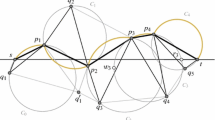Abstract
The problem of routing data packets in a constant-degree network is considered. A routing scheme is calledoblivious if the route taken by each packet is uniquely determined by its source and destination. The time required for the oblivious routing ofn packets onn processors is known to be Θ(√n). It is demonstrated that the presence of extra processors can expedite oblivious routing. More specifically, the time required for the oblivious routing ofn packets onp processors is Θ(n/√p + logn).
Similar content being viewed by others
References
A. Borodin and J. E. Hopcroft, Routing, merging and sorting on parallel models of computation,Proc. 14th Ann. ACM Symp. on Theory of Computing, San Francisco, CA, May 1982.
L. M. Goldschlager, A universal interconnection pattern for parallel computers,J. Assoc. Comput. Mach., vol. 29, no. 4, pp. 1073–1086, Oct. 1982.
A. Gottlieb, R. Grishman, C. P. Kruskal, K. P. McAuliffe, L. Rudolph, and M. Snir, The NYU ultracomputer-designing an MIMD shared memory parallel computer,IEEE Trans. Comput., vol. 32, no. 2, Feb. 1983.
T. Lang, Interconnections between processors and memory modules using the shuffle-exchange network,IEEE Trans. Comput., vol. 25, no. 5, May 1976.
D. Nassimi and S. Sahni, Data broadcasting in SIMD computers,IEEE Trans. Comput., vol. 30, no. 2, pp. 101–106, Feb. 1981.
D. Nassimi and S. Sahni, Parallel permutation and sorting algorithms and a new generalized connection network,J. Assoc. Comput. Mach., vol. 29, no. 3, pp. 642–667, July 1982.
I. Parberry, A complexity theory of parallel computation, PH.D. Thesis, Department of Computer Science, University of Warwick, May 1984.
I. Parberry, On recurrent and recursive interconnection patterns,Inform. Process. Lett., vol. 22, no. 6, pp. 285–289, May 1986.
I. Parberry,Parallel Complexity Theory, Research Notes in Theoretical Computer Science, Pitman, London, 1987.
I. Parberry, Some practical simulations of impractical parallel computers,Parallel Comput., vol. 4, no. 1, pp, 93–101, Feb. 1987.
F. P. Preparata and J. Vuillemin, The cube-connected cycles: a versatile network for parallel computation,Comm. ACM, vol. 24, no. 5, pp. 300–309, May 1981.
C. L. Seitz, The cosmic cube,Comm. ACM, vol. 28, no. 1, pp. 22–23, Jan. 1985.
H. S. Stone, Parallel processing with the perfect shuffle,IEEE Trans. Comput., vol. 20, no. 2, pp. 153–161, Feb. 1971.
J. D. Ullman,Computational Aspects of VLSI, Computer Science Press, Rockville, MD, 1984.
Author information
Authors and Affiliations
Additional information
Communicated by C. K. Wong.
Rights and permissions
About this article
Cite this article
Parberry, I. An optimal time bound for oblivious routing. Algorithmica 5, 243–250 (1990). https://doi.org/10.1007/BF01840387
Received:
Revised:
Issue Date:
DOI: https://doi.org/10.1007/BF01840387




